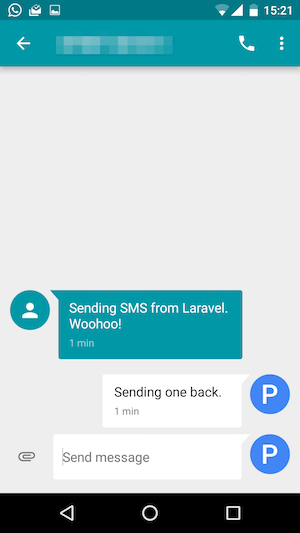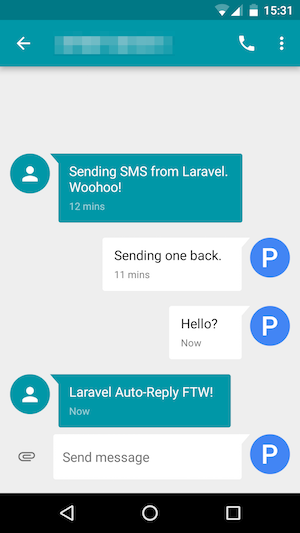Sending and receiving SMS using Laravel and Nexmo

In this quick guide from Phil Leggetter, we will look at how to send and receive SMS in the Laravel app. We realize this opportunity using Nexmo , a cloud communication platform that offers API interfaces for initializing phone numbers, sending and receiving SMS (which we will use), as well as for making calls.
Prerequisites
We will need a Nexmo account installed by the Nexmo CLI (command line interface), as well as your pre-installed Laravel application. In addition, local tunneling is required so that the Nexmo service can make an HTTP request to the local web server. We recommend ngrok .
')
Introduction
First we will create our Laravel SMS application:
composer create-project --prefer-dist laravel/laravel laravel-sms cd laravel-sms Next, add the Nexmo Laravel package to composer.json:
"require": { ..., "nexmo/laravel": "dev-master as 1.0", "nexmo/client": "dev-master as 1.0" }, Note: when these packages are out of beta, you only need to enable the
nexmo/laravel , and the nexmo/client will be added automatically as a dependency.Add the Nexmo service provider to your
app.php configuration file: 'providers' => [ ..., Nexmo\Laravel\NexmoServiceProvider::class ] Note: you can also add it to
aliases if you want to use a facade.Install the packages and copy the Nexmo configuration file:
› composer update php artisan vendor:publish Finally, add the Nexmo API Key and API Secret to
/config/nexmo.php , update the API_KEY and API_SECRET values based on the values contained in the API settings in Nexmo Dashboard. 'api_key' => 'API_KEY', 'api_secret' => 'API_SECRET', Note: if you wish, you can declare values in
.env and env(...) .SMS sending
Note: for simplicity, we will add all the functionality to
app/Http/routes.php .Add the following route to
app/Http/routes.php : Route::get('/sms/send/{to}', function(\Nexmo\Client $nexmo, $to){ $message = $nexmo->message()->send([ 'to' => $to, 'from' => '@leggetter', 'text' => 'Sending SMS from Laravel. Woohoo!' ]); Log::info('sent message: ' . $message['message-id']); }); It is worth noting that in the above code,
from contains the value of @leggetter . This will work in the UK, but not in other countries.
For those of you who need to use a real number, let's consider using an existing number, as well as purchasing it.
Listing, search and rent numbers
One of the prerequisites for this lesson was the Nexmo CLI . We can use it for a variety of actions, including working with phone numbers (virtual numbers, to be exact) that are associated with our account. If you have not done so already, you must install and configure the CLI, where
API_KEY and API_SECRET should be replaced with the API credentials that were previously used: › npm install -g nexmo-cli nexmo setup API_KEY API_SECRET Now we can view the available rooms that we have already rented, search for rooms available for rent, as well as rent or cancel the rental of a specific room. Let's start by looking at the list of numbers that are already available on our account:
› nexmo number:list 14155550123 In the example above, I have a number. If you do not have a number, you can search for rental numbers. All you need to know for this is the two characters of the country code in ISO 3166-1 alpha-2 format . In fact, it is easier than it seems. For example, for Great Britain it is GB , and for the United States - US (approx.: And for Russia - RU ). Let's find a room to rent in the US:
› nexmo number:search US 14155550111 14155550222 14155550333 If you do not have a number, you must buy it, after which you can send and receive SMS in those countries that require a real outgoing number.
› nexmo number:buy 14155550111 --confirm Number purchased: 14155550111 Sending SMS, finally!
Now you need to update the code to use the number you just bought. To do this, change the value
from to env('NEXMO_NUMBER') , as in the example below: Route::get('/sms/send/{to}', function(\Nexmo\Client $nexmo, $to){ $message = $nexmo->message()->send([ 'to' => $to, 'from' => env('NEXMO_NUMBER'), 'text' => 'Sending SMS from Laravel. Woohoo!' ]); Log::info('sent message: ' . $message['message-id']); }); Then start the server:
› php artisan serve Laravel development server started on http://localhost:8000/ And go to
http://localhost:8000/sms/send/YOUR_NUMBER , where YOUR_NUMBER should be replaced with a real number, including the country code, in E.164 format, i.e. in the same format that was shown in all the examples above.In the
storage/logs/laravel.log you will see a log entry related to the message that was just sent, including a unique message identifier at the end of the record, for example: [2016-08-02 13:45:01] local.INFO: sent message: 03000000068F5D97 Receive incoming SMS
In order for our application to receive incoming SMS, we need to perform several actions:
- Make sure the application is visible to Nexmo through the local tunnel.
- Create a route to receive SMS
- Disable CSRF for route receiving SMS
- Tell Nexmo which route to call the webhook when receiving a message.
To begin with, we will give the Nexmo platform access to our application through a local tunnel. Assuming you are using ngrok and your Laravel web server is listening on port 8000, you can do this as follows:
› ngrok http 8000 ngrok by @inconshreveable (Ctrl+C to quit) Tunnel Status online Version 2.1.3 Region United States (us) Web Interface http://127.0.0.1:4041 Forwarding http://814882e9.ngrok.io -> localhost:8000 Forwarding https://814882e9.ngrok.io -> localhost:8000 Connections ttl opn rt1 rt5 p50 p90 0 0 0.00 0.00 0.00 0.00 Above, you can see that the subdomain on ngrok has been successfully created and now any requests to it will be tunnelled to our local host
localhost:8000 .Now you need to create a route for receiving SMS in the
routes.php file: Route::post('/sms/receive', function(\Nexmo\Client $nexmo){ }); By default, Laravel will not miss POST requests for this route without a CSRF token . Since the request for this route will be made by Nexmo, which has no token, we need to disable CSRF for this route. Add the following to
App/Http/Middleware/VerifyCsrfToken.php : protected $except = [ '/sms/receive' ]; And finally, let's tell Nexmo which route to make a web-based call when an SMS is received. We can do this with the Nexmo CLI. When executing the following command, you must use the phone number you rented, as well as your ngrok subdomain:
› nexmo link:sms 14155550111 https://814882e9.ngrok.io/sms/receive Number updated When you run this command, the Nexmo service will try to call your route
/sms/receive , and you should see a request in the ngrok terminal: HTTP Requests ------------- POST /sms/receive 200 OK The Nexmo PHP client library provides the ability to easily capture the HTTP parameters that were sent from Nexmo to the Laravel application and create an
InboundMessage incoming message InboundMessage that we can work with. Update the route code /sms/receive as follows: Route::post('/sms/receive', function(\Nexmo\Client $nexmo){ $message = \Nexmo\Message\InboundMessage::createFromGlobals(); Log::info('got text: ' . $message->getBody()); }); After that, send an SMS to the rented number and check
storage/logs/laravel.log ; the message you sent should be in the log. [2016-08-02 13:45:01] local.INFO: sent message: 03000000068F5D97 [2016-08-02 14:20:50] local.INFO: sent message: 0300000006917797 [2016-08-02 14:21:17] local.INFO: got text: Sending one back. 
Auto reply to incoming SMS
And finally, let's create an answering machine for the incoming message. The Nexmo PHP client provides a good way to do this with the
InboundMessage->createReply function: Route::post('/sms/receive', function(\Nexmo\Client $nexmo){ $message = \Nexmo\Message\InboundMessage::createFromGlobals(); Log::info('got text: ' . $message->getBody()); $reply =$nexmo->message()->send($message->createReply('Laravel Auto-Reply FTW!')); Log::info('sent reply: ' . $reply['message-id']); }); Send a message to the rented room and you will receive an automatic response. This is almost magic!

Conclusion
In this tutorial, we covered everything you need to know in order to send and receive SMS, and even automatically reply to SMS, in the Laravel application using the Nexmo cloud communications platform.
You can find the code for this tutorial at github.com/nexmo-community/laravel-sms .
Source: https://habr.com/ru/post/307278/
All Articles